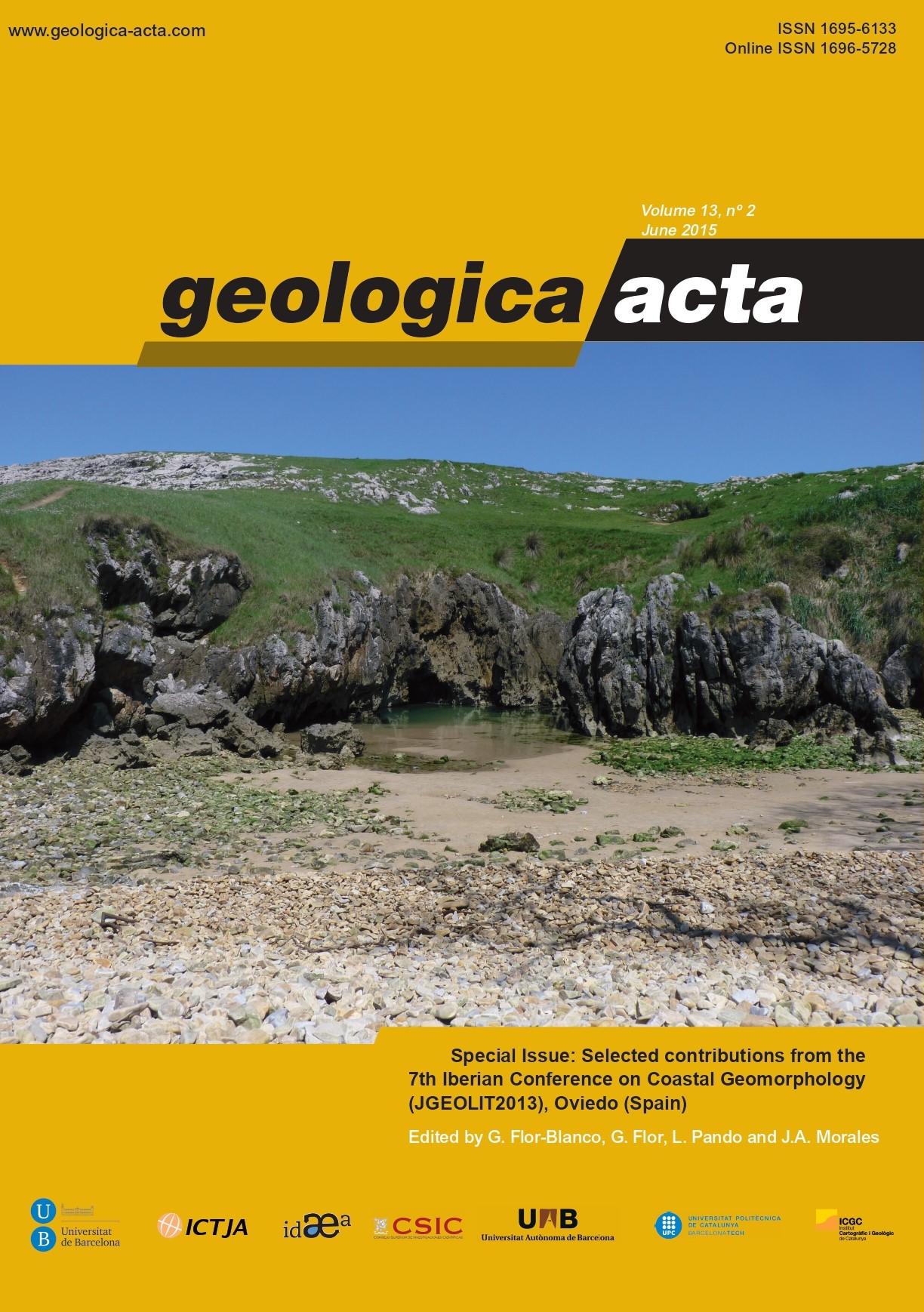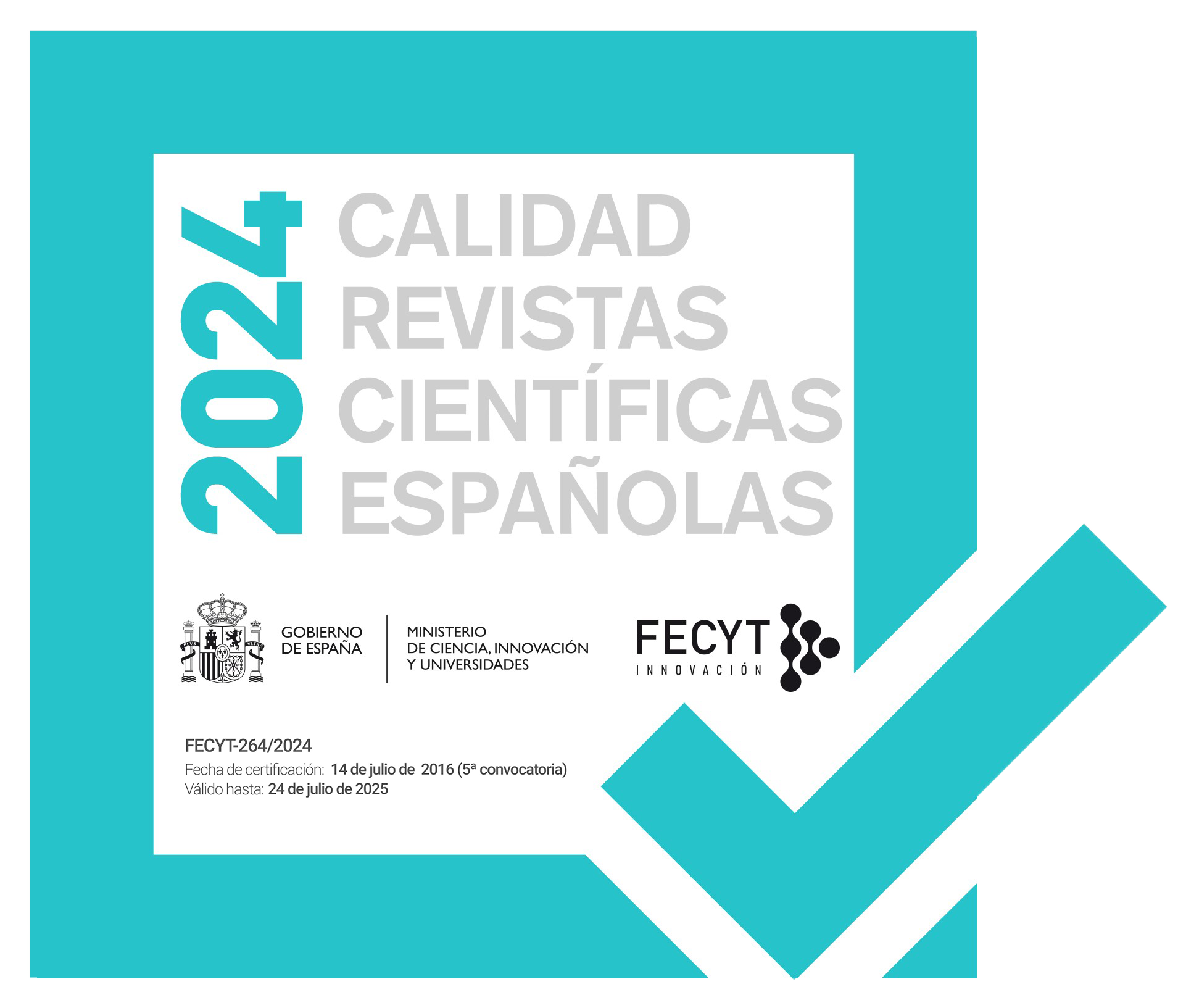GIS as a tool to detect flat erosional surfaces in coastal areas: a case study in North Spain
DOI:
https://doi.org/10.1344/GeologicaActa2015.13.2.2Keywords:
Flat erosional surface, Rasa, GIS, Asturias, SpainAbstract
The delimitation of flat surfaces, such as marine or continental terraces, can be easily done if they are wellpreserved by using classic techniques such as fieldwork and photointerpretation. However, subsequent landscapeerosion can modify their initial morphology, hindering their recognition. This paper presents a methodologydesigned to identify and delineate flat erosional surfaces (known as rasas) in a sector of 1,228km2 in theCantabrian coast (eastern Asturias, N Spain). The spatial distribution of rasas was quantitatively established by comparing the Digital Terrain Model (DTM) with previously available information about flat surfaces alreadymapped. From a lithological point of view, rasas are modelled on Ordovician quartzite (9.7km2 of 1,228) mainlybetween 132–232m above sea level (a.s.l.) altitude and on Carboniferous limestone (2.9km2 of 1,228) mainlybetween 24–69m a.s.l. The use of Geographic Information Systems (GIS) combined with a quantitative analysisof the relief (using the hypsometric method) allowed us to develop a predictive approach for flat erosionalsurface detection. The methodology has been tested and validated in areas in which there were no erosionalsurfaces previously mapped. The results reveal new surfaces modelled on Ordovician quartzite (0.43km2), ataltitudes ranging from 200 to 250m, on Jurassic mixed formations (35.9km2) at 150–175m altitude, and onEocene limestone (1.1km2) at 110–120m altitude.
References
Álvarez-Marrón, J., Hetzel, R., Niederman, S., Menéndez, R., Marquínez, J., 2008. Origin, structure and exposure history of a wave-cut platform more than 1Ma in age at the coast of northern Spain: a multiple cosmogenic nuclide approach. Geomorphology, 93, 316-334.
Anderson, R.S., Densmore, A.L., Ellis, M.A., 1999. The generation and degradation of marine terraces. Basin Research, 11, 7-19.
Aramburu, C., Bastida, F., 1995. Mapa geológico de Asturias. In: Aramburu, C., Bastida, F. (eds.). Geología de Asturias. Gijón,
Ediciones Trea, S.L., 308pp.
Beroiz, C., Barón, A., Ramírez del Pozo, J., Giannini, G., Gervilla, M., 1972. Cartografía Geológica de la Hoja Nº 30 (Villaviciosa) del Plan MAGNA a escala 1:50.000. IGME.
Blanco-Chao, R., Costa-Casais, M., Valcárcel-Díaz, M., PérezAlberti, A., Trenhaile, A.S., 2003. Evolution and inheritance of a rock coast: western Galicia, northern Spain. Earth Surface Processes and Landforms, 28, 757-775.
Ebert, K., Hättestrand, C., Hall, A.M., Alm, G., 2011. DEM identification of macroscale stepped relief in arctic northern Sweden. Geomorphology, 132, 339-350.
Feal-Pérez, A., Blanco-Chao, R., Valcárcel-Díaz, M., 2009. Plataformas de abrasión, plataformas litorales y terrazas marinas o rasas. In: Flor, G., Flor-Blanco, G., Gallastegui, J.; Martín-Llaneza, J. (eds.). Nuevas Contribuciones al Margen Ibérico Atlántico (MIA09), 177-180.
Flor, G., 1983. Las rasas asturianas: ensayo de correlación y emplazamiento. Trabajos de Geología, Universidad de Oviedo, 13, 65-81.
Flor, G., 2000. El entorno geológico del río y la playa de Bedón. En Bedoniana, Oviedo. Anuario de San Antolín y Naves, Alvízoras Llibros, 55-74.
Flor, G., Flor-Blanco, G., 2009. Aspectos morfológicos, dinámicos y sedimentarios del sector costero: desembocadura del Nalón - playa de Bañugues. Problemática ambiental. Guía de campo. 6º Simposio sobre el Margen Ibérico Atlántico (MIA09), 61pp.
Flor, G., Flor-Blanco, G., 2014. Raised beaches in the Cantabrian Coast. In: Gutiérrez, F., Gutierrez Elorza, M. (eds.). Landscapes and Landforms in Spain. Springer, 239-248.
Flor, G., Peón, A., 2004. Rasas y superficies de erosión continental en el relieve alpídico del noroeste peninsular y los depósitos terciarios. In: Araújo, M.A., Gomes, A. (eds.). Geomorfología del NW de la Península Ibérica. Facultade de Letras, Universidade de Porto, 13-31.
Flor-Blanco, G., 2007. Características morfosedimentarias y dinámicas y evolución ambiental de los estuarios de Tina Mayor, Tina Menor y San Vicente de la Barquera (Costa Occidental de Cantabria). Doctoral Thesis (unpublished). Universidad de Oviedo, 477pp.
García-Ramos, J.C., Gutiérrez Claverol, M., 1995. La cobertera mesozoico-terciaria. In: Aramburu, C., Bastida, F. (eds.). Geología de Asturias, 81-94.
González-Amuchástegui, M.J., Serrano Cañadas, E., Edeso Fito, J.M, Meaza Rodríguez, G., 2005. Cambios en el nivel del mar durante el Cuaternario y morfología litoral en la costa oriental cantábrica (País Vasco y Cantabria). In: Mateu, J.F., Sanjaume, E. (eds.). Geomorfologia Litoral i Quaternari. Homenatge al professor Vicenç M. Rosselló i Verger, 167-180.
González-Fernández, J.A., 2012. Utilización de los SIG para la caracterización del relieve en el entorno de Ribadesella. Master Thesis. Universidad de Oviedo, 61pp.
Gutiérrez Claverol, M., López Fernández, C., Alonso, J.L., 2006. Procesos neotectónicos en los depósitos de rasa de la zona de Canero (Occidente de Asturias). Geogaceta, 4, 75-78.
Gutiérrez Elorza, M., 2008. Geomorfología. Pearson-Prentice Hall, 898pp.
Jiménez-Sánchez, M., Anadón-Ruiz, S., Farias, P., GarcíaSansegundo, J., Canto-Toimil, N., 2002. Estudio preliminar de la Geomorfología de la Cueva de El Pindal (Ribadedeva, Oriente de Asturias). Geogaceta, 31, 47-50.
Jiménez-Sánchez, M., Anadón Ruiz, S., Farias, P., GarcíaSansegundo, J., Canto Toimil, N., 2004. Geomorfología de la cueva de Tito Bustillo y del macizo kárstico de Ardines (Ribadesella, Costa Cantábrica, Norte de España). Boletín Geológico y Minero, 115(2), 257-263.
Jiménez-Sánchez, M, Bischoff, J., Stöll, H., Aranburu, A., 2006. A geochronological approach for cave evolution in the Cantabrian Coast (Pindal Cave, NW Spain). Zeitschriftfür Geomorphologie, 147, 129-141.
Llopis Lladó, N., 1954. El relieve de la región central de Asturias. Estudios Geográficos, 17(57), 501-550.
Marquínez, J., 1989. Mapa geológico de la Región del Cuera y los Picos de Europa. Trabajos de Geología, Universidad de
Oviedo, 18, 137-144.
Martínez García, E., 1980. Cartografía Geológica de la Hoja Nº 32 (Llanes) del Plan MAGNA a escala 1:50.000. IGME.
Mary, G., 1983. Evolución del margen costero de la cordillera cantábrica en Asturias desde el Mioceno. Trabajos de Geología, Universidad de Oviedo, 13, 3-35.
Mary, G., 1985. Les éboulis périglaciaires le long du littoral asturien et galicien. Actas I Reunión del Cuaternario Ibérico, I, 119-126.
Merino-Tomé, O., Suárez Rodríguez, A., Alonso Alonso, J.L., González Menéndez, L., Heredia, N., Marcos Vallaure, A., 2011. Mapa Geológico Digital continuo E. 1:50.000, Principado de Asturias (Zonas: 1100-1000-1600). In: Navas, J. (ed.). GEODE. Mapa Geológico Digital continuo de España. IGME. http://cuarzo.igme.es/sigeco.
Miranda Duque, F., Villar García, D., Flor, G., 2004. Morfologías continentales de erosión del área sur-central de Asturias. Modelo evolutivo. Contribuciones Recientes sobre Geomorfología, VIII Reunión Nacional de Geomorfología, I, 23-30.
Moñino, M., 1986. Establecimiento y cartografía de los niveles de rasa litoral existentes en Cantabria. Tesis de Licenciatura. Universidad de Cantabria, 178pp.
Moñino, M., Díaz de Terán, J.R., Cendrero, A., 1988. Pleistocene sea level changes in the Cantabrian coast, Spain. In: Singh, S., Tiwari, R.C. (eds.). Geomorphology and Environment. Allahabad, India, The Allahabad Geographical Society, 351-364.
Moreno, F., Mediato, J.F., Canas, V., 2009. Terrazas marinas en el litoral de Cantabria. Controles litológicos del sustrato. In: Flor, G., Flor-Blanco, G., Gallastegui, J., Martín-Llaneza, J. (eds.). Nuevas Contribuciones al Márgen Ibérico Atlántico (MIA09), 181-184.
Moura, D., Albardeiro, L., Veigas-Pires, C., Boski, T., Tigano, E., 2006. Morphological features and processes in the central Algarve rocky coast. Geomorphology, 81, 345-360.
Navarro, D., 1984. Cartografía Geológica de la Hoja Nº 31 (Ribadesella) del Plan MAGNA a escala 1:50.000. IGME. Pinatelli, R., Giannini, G., Ramírez del Pozo, J., Beroiz, C., Barón, A., 1972. Cartografía Geológica de la Hoja Nº 15 (Lastres) del Plan MAGNA a escala 1:50.000. IGME.
Portero, J.M., Ramírez del Pozo, J., Olivé, A., Martín, J.M., 1974. Cartografía Geológica de la Hoja Nº33 (Comillas) del Plan MAGNA a escala 1:50.000. IGME.
Principado de Asturias, 2002. Cartografía Temática Ambiental de Asturias a escala 1:25.000. Servicio de Cartografía del Principado de Asturias.
Pulgar, J.A., Alonso, J.L, Espina, R.G., Marín, J.A., 1999. La deformación alpina en el basamento varisco de la Zona Cantábrica. Trabajos de Geología, Universidad de Oviedo, 21, 283-294.
Rivas, V., 2000. Clima y nivel del mar: reconstrucción de las posiciones marinas cuaternarias a través de las evidencias en el litoral cantábrico. In: García-Codrón, J.C. (ed.). La reconstrucción del clima de época preinstrumental. Santander, Published by the University of Cantabria, 179-212.
Rodríguez-Asensio, J.A., Noval Fonseca, M.A., Barrera Logares, J.M., 1999. Estratigrafía del Pleistoceno medio-superior en la
Rasa Litoral Cantábrica (Asturias). In: Pallí Buxó, L., Roqué Pau, C. (eds.). Avances en el estudio del Cuaternario español. Girona, Cuaternario, 253-258.
Sunamura, T., 1978. A model of the development of continental shelves having erosional origin. Geological Society of America Bulletin, 89(4), 504-510.
Sunamura, T., 1991. The elevation of shore platforms: a laboratory approach to the unsolved problem. The Journal of Geology, 761-766.
Tosal, J.M., 1968. Relaciones zócalo-cobertera en el límite de las provincias de Oviedo y Santander. Breviora Geologica Asturica, 12, 9-14.
Trenhaile, A.S., 1987. The Geomorphology of Rock Coast. London, Clarendon Press, 384pp.
Trenhaile, A.S., 2002. Modeling the development of marine terraces on tectonically mobile rock coasts. Marine Geology, 185, 341-361.
Trenhaile, A.S., 2014. Modeling the effect of Pliocene–Quaternary changes in sea level on stable and tectonically active land masses. Earth Surface Processes and Landforms, 39(9), 1221-1235.
Downloads
Published
Issue
Section
License

This work is licensed under a Creative Commons Attribution-ShareAlike 4.0 International License.
Copyright
Geologica Acta is the property of the UB, GEO3BCN, IDAEA and UAB. Geologica Acta must be cited for any partial or full reproduction. Papers are distributed under the Attribution-Share Alike Creative Commons License. This license allows anyone to reproduce and disseminate the content of the journal and even make derivative works crediting authorship and provenance and distributing possible derivative works under the same or an equivalent license.
Author Rights
Authors retain the copyright on their papers and are authorized to post them on their own web pages or institutional repositories. The copyright was retained by the journal from the year 2003 until 2009. In all cases, the complete citation and a link to the Digital Object Identifier (DOI) of the article must be included.
The authors can use excerpts or reproduce illustrations of their papers in other works without prior permission from Geologica Acta provided the source of the paper including the complete citation is fully acknowledged.




